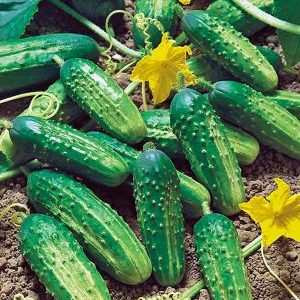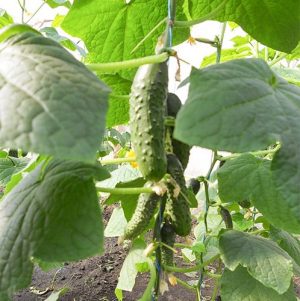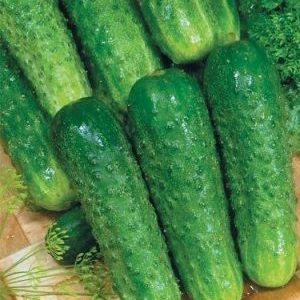Ajax f1 cucumber hybrid review: features, advantages and disadvantages
Ajax F1 is a consistently productive hybrid that gardeners love for its resistance to adverse weather events and the marketable appearance of the fruit. Fans of pickles and pickled vegetables should pay attention to this crop, since Ajax F1 is especially good for harvesting for the winter.
The content of the article
Description of the hybrid
Cucumber Ajax F1 is a very early hybrid created by the Dutch breeders of the Nunhems company. At the beginning of the XXI century, it was added to the state register of horticultural crops in Russia. The hybrid is intended for growing in the open field in summer cottages and on an industrial scale.
The culture has powerful, large, open-looking bushes with high climbing ability. Leaves are medium, wrinkled, rich green. Ajax F1 is pollinated by bees, the flowering type is female.
Cucumbers grow cylindrical, up to 12 cm long and weighing 80-100 g. Fruits are genetically free of bitterness, they can be eaten fresh or used for canning. It is permissible to harvest at the stage of pickles (3-5 cm in length) and gherkins (7-9 cm).
The culture begins to bear fruit early, 40-50 days after the appearance of the first shoots, and continues to yield until the first autumn frosts. The plant perfectly tolerates sudden changes in temperature, is not afraid of cold snaps and heat.

Important! The bushes quickly and actively stretch out in height, so experienced gardeners recommend growing them on a support. For these purposes, trellises, pegs or a net can be placed on the garden bed.
Distinctive features
Ajax F1 differs from other varieties and hybrids:
- lack of bitterness in fruits;
- congenital resistance to major diseases;
- high yields (with early sowing and good care);
- marketable type of cucumbers.
Composition, benefits, calories
The calorie content of fresh cucumbers is 13 kcal, pickled - 16.2 kcal. Nutritional value of 100 g of fruits:
- proteins - 0.9 g;
- carbohydrates - 2.4 g;
- fats - 0.01 g;
- water - 96.69 g.
The product has a rich chemical composition of the following elements:
- alimentary fiber;

- starch;
- organic acids;
- mono - and disaccharides;
- beta carotene;
- vitamin A;
- B vitamins (thiamine, folates, pyridoxine, pantothenic acid, riboflavin, choline);
- vitamin C;
- vitamin E;
- vitamin K;
- vitamin PP;
- ash;
- biotin;
- niacin;
- macronutrients (sulfur, potassium, chlorine, calcium, phosphorus, magnesium, silicon, sodium);
- trace elements (aluminum, zinc, boron, iodine, iron, fluorine, chromium, manganese, selenium).
The fruits are endowed with many useful properties:
- improve kidney function;
- relieve heartburn and heaviness in the abdomen;
- remove toxins, toxins, heavy metal salts and excess fluid from the body;
- stop the formation of adipose tissue at the waist and sides;
- bring blood pressure back to normal;
- improve the condition of the skin, hair and nails;
- heals the joints;
- reduce the concentration of uric acid;
- remove harmful substances formed as a result of drinking alcoholic beverages, and relieve a hangover;
- relieve pain with gout, arthritis;
- relieve inflammation in the oral cavity;
- reduce the level of bad cholesterol;
- improve digestion;
- make up for the lack of fluid in the body.
Reference. Cucumbers have anti-inflammatory properties, so they are often used for cosmetic purposes.Vegetable slices can relieve swelling, remove bags and bruises under the eyes.
Specifications
The table shows the main characteristics of the bushes, fruits and taste of the hybrid.
| Parameter | Specifications |
| Bushes | Indeterminate, open-minded, moderate stepchildren. The body is high, strongly stretched upwards. |
| Ripening terms | 40-50 days |
| Yield | 5-10 kg / m2 |
| Fruit | Correct cylindrical shape, length - up to 12 cm, weight - up to 100 g |
| Taste qualities | The pulp without bitterness and voids, crispy, juicy, pale green color, with a pleasant taste and aroma |
| Purpose | It is considered the best variety for salting, pickling and canning |
| Pollination type | Entomophilous (pollinated by bees) |
| Disease resistance | Resistant to powdery mildew, mosaic virus and brown spot |
| Marketable condition | Excellent, fruits are not prone to yellowing, they tolerate transportation well |
How to grow yourself
The hybrid is undemanding to care and growing conditions, so its agricultural technology will not seem difficult even for novice gardeners.
Attention! The crop needs pollination by bees, so it shouldn't be planted to greenhouses and greenhouses.
Landing
Cultivation of Ajax F1 begins with receiving seedlings or sowing in a summer cottage. He is unpretentious to the composition and parameters of the soil, but for a bountiful harvest, the bed should be well fertilized. Preparation of the planting site begins in the fall, removing all weeds along with the roots, applying organic fertilizers and digging the soil to a depth of 15-20 cm.
As feeding better to use:
- humus;
- peat;
- chicken droppings;
- mullein.
Planting with seedlings or seeds is carried out in late April - early June, focusing on the weather conditions of the region. By this time, the soil should warm up to 15-18 ° C. Before planting, the bed is dug up, weeds are removed, earth lumps are broken and leveled. At the same time, do not forget to add 40 g of superphosphate and a glass of ash for each square meter of soil.
If bulk beds in boxes are formed on the site, the soil in them can be replaced with fresh ones. Ajax F1 likes the mixture of the following ingredients:
- humus;
- sod land;
- peat;
- garden land.
The components are combined in a 1: 1: 1: 1 ratio, 20 g of superphosphate and 250-300 g of wood ash are added to each bucket of the mixture.
Seeds also need to be prepared according to the following algorithm:
- 1 g of potassium permanganate is dissolved in half a glass of water.
- The planting material is placed in the resulting solution for 10-15 minutes.
- The seeds are washed in clean water and wrapped in damp gauze or cotton cloth.
- Sprouted seeds are placed in a moderately cold place for a day.
After these actions, they are sown on seedlings or immediately into open ground.
Seed method
The scheme for planting seeds in open ground is presented in the following table.
| Penetration depth | 2 cm | |
| Distance between | in rows | 60 cm |
| bushes | 15-20 cm | |
Sowing is carried out as follows:
- Thoroughly loosen the soil in the garden.
- Make holes 2 cm deep and moisten them with warm water.
- 2-3 seeds are placed in each hole and covered with fluffy, light soil.
- Before the first shoots appear, it is important to regularly water the garden bed with warm water from a spray bottle or a watering can with a diffuser, so as not to blur the plantings.
If several plants rise in the holes at once, their number is reduced to one in each. To do this, the bushes are simply pulled out or transplanted into empty holes, where nothing has sprung up.
Seedling method
The seedling method allows you to get the first harvest 10-14 days earlier. For this, the seeds are planted in containers filled with damp and light earth, and after 1-1.5 months the grown bushes are moved to the garden bed.
Seedling care is as follows:
- As the land dries up, irrigate with warm, settled water.
- Maintain a temperature favorable for growth and development. During the day it should remain at 19-25 ° С, and at night - 17 ° С.
- 10-14 days before transplanting into open ground, the bushes are watered at the root with a solution of the following components: 10 g of potassium sulfate, 15 g of superphosphate and 5 liters of water.
- A week before moving, the seedlings are hardened. To do this, every day it is removed to a room with an air temperature of 14-16 ° C for 2-3 hours.
Ready-to-transplant cucumbers should have thick, well-developed stems and healthy, vibrant leaves. They are planted in open ground according to the following scheme:
- On the garden bed, planting pits are formed 2-3 cm larger than the diameter of the earthen clod of seedlings.
- It is taken into account that a distance of 50-60 cm should be maintained between the rows, and 15-20 cm between the pits.
- The holes are moistened with warm water, plants are placed in them, sprinkled with earth and gently tamped down to give the bushes stability.
Ajax F1 has a superficial root system and a large leaf apparatus. This indicates that the shrubs will be more comfortable in wet conditions rather than dry ones.
Step-by-step cultivation and care
Outdoor growing and care rules:
- Loosen the soil after each watering and rain so that a hard crust does not form on the surface of the earth. It will prevent moisture and air from penetrating to the roots.
- Water the culture with warm, settled water. At the same time, do not allow strong waterlogging and drying out of the soil.
- Once every 10-14 days, pull out all the weeds from the garden along with the roots.
- Make sure that the plants do not fall over or spread over the soil. To do this, carefully tie them up and fix them on the supports. Do not pinch the stems so as not to disrupt the processes of sap flow.
- With a strong thickening of the plantings, remove excess leaves and side shoots from the lashes. It is also recommended to pinch the tops of 2-meter bushes so that they do not stretch even more.
During the season, it is enough to feed the culture three times:
- After transplanting the seedlings to a permanent place or the formation of a pair of true leaves when sowing in open ground, sprinkle the bed with Ammofoskoy and loosen (5 g of the product per 1 m2 of soil).
- After the first flowers appear. In 10 l of water, dilute 20 g of ammonium nitrate, 10 g of potassium nitrate and 20 g of superphosphate. Use a solution for watering the bushes at the root.
- During fruiting. Fill half of the bucket with liquid cow dung and fill with water to the brim. Insist in a warm place for about a week, water the cucumbers at the root.
Do not use chlorine-containing dressings.
Features of cultivation and possible difficulties
When cultivating Ajax F1, you can face the following difficulties:
| Problem | Cause | Solutions |
| Bushes wither. | The plant lacks water or suffers from frequent overflows. | Adjust the irrigation regime, do not allow the soil to dry out and waterlogged. |
| As they ripen, the cucumbers are deformed, becoming pear-shaped. | Lack of potassium. | Pour a glass of ash with 10 liters of warm water and leave for 1-2 days. Pour 1 liter of the product under each plant. Repeat the procedure once a week until the problem goes away. |
| Small rounded holes are visible on the foliage. | Sunburn. | Shade the cucumbers: plant ornamental bushes, corn, sunflowers around the garden, or cover them with transparent material during the hot hours. |
| Scourges grow slowly and develop poorly, seemingly weak and frail. | Nitrogen deficiency. | 4 tsp Dilute "Nitrofoski" in 5 liters of water. Add a glass of solution under each bush. |
Typical diseases and pests, resistance
The hybrid is genetically resistant to mosaic, powdery mildew and spotting. But Ajax F1 can be infected with gray rot. To prevent this from happening, it is enough not to let the leaves come into contact with the soil. To do this, the lashes are tied up and do not allow thickening of the landings.
Cucumbers are often attacked by pests: slugs, spider mites, melon aphids. To protect plants from these insects, you can use one of the most effective folk remedies:
- Bury fresh onion and garlic husks between rows and bushes.
- Dissolve 0.5 kg of wood ash and 150 g of shavings of laundry soap in a bucket of water. Moisten the foliage and stems of all cucumbers liberally.
- Grind the head of garlic together with the husk in a blender, pour 5 liters of hot water and leave for 1-2 days. Strain the product and use for spraying.
Harvesting and application of the crop
The picking of cucumbers begins 40-50 days after the appearance of the first shoots and continues until the first frost. The crop can be eaten fresh, but Ajax fruits are more suitable for processing for the winter.
Advantages and disadvantages
Ajax hybrid advantages:
- a bountiful harvest;
- resistance to cold and frost;
- great taste in canned, pickled and salted form;
- marketable condition;
- tolerates transportation well;
- suitable for growing on an industrial scale;
- immunity to disease;
- suitable for growing on pickles.
But besides the advantages, the hybrid has a number of disadvantages:
- needs pollination by bees;
- mediocre fresh taste;
- not suitable for growing in greenhouses;
- dense skin.
Reviews
Reviews of the Ajax F1 hybrid are mostly positive. Gardeners appreciate it for its undemanding care and aesthetic appearance.
Alexey, Moscow: «The hybrid pleased with a rich harvest. I planted a lot of bushes, there was nowhere to put the cucumbers, I distributed them to colleagues and friends. Their taste is soft and delicate, I liked it. In salads, Ajax F1 does not interrupt other components, and pickled cucumbers absorb the aroma of spices. "
Alena, Izhevsk: “Cucumbers Ajax F1 are even, of the same size, they look very good in cans, it is not a shame to put them on the table in front of guests. I salt them and add them to canned salads for the winter. "
Conclusion
Grow the Ajax F1 hybrid based on planting and grooming recommendations. In this case, he will not cause you problems, and will also delight you with a rich harvest. Do not forget that this culture is the record holder for fruit formation, so remove the cucumbers every day, otherwise the plant may break under their weight.